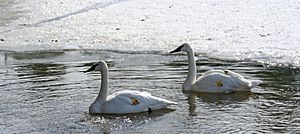Wye Marsh facts for kids
Quick facts for kids Wye Marsh |
|
|---|---|
 |
|
| Location | Simcoe County |
| Nearest city | Midland, Ontario |
| Area | 1000 hectares 920 hectares (Wye Marsh Wildlife Management Area) 47 hectares (Wye Marsh National Wildlife Area) |
| Visitors | 35000 (in 2001) |
The Wye Marsh is a special wetland area located in Ontario, Canada. You can find it on the southern shores of Georgian Bay. This important place was officially made the Wye Marsh National Wildlife Area in 1978. The Ontario Ministry of Natural Resources calls it a "Provincially Significant Wetland." This means it's a really important natural area for the province.
Contents
Who Lived at Wye Marsh?
When European Jesuit missionaries arrived in 1639, the Huron (also called Wyandot) lived here. The Jesuits built a mission near Wye Lake. This site is now known as Sainte-Marie among the Hurons. The biggest Huron village was located between Wye Marsh and Tiny Marsh.
Around 1650, battles with the Iroquois people caused the Huron and missionaries to leave. They moved to Quebec. For about 150 years after that, the Wye Marsh area was mostly empty.
European Settlement and Changes
In the early 1800s, a naval base opened in Penetanguishene. This led to more Europeans settling in the area. Wyebridge became an important business center in Simcoe County. By the 1860s, Midland was a huge logging town.
However, cutting down too many trees (deforestation) caused problems. Small streams that fed the marsh started to dry up. Also, a lot of soil erosion happened along the Wye River. This soil washed into Wye Lake. Later, in the 1900s, Wye Marsh was a private hunting area. Eventually, the Canadian and provincial governments turned it into a wildlife area.
How Wye Marsh is Managed
The Canadian Wildlife Service created the Wye Marsh Wildlife Centre in 1969. In 1985, a group called the Friends of the Wye Marsh took over running the center. They work with Environment Canada to manage it.
Most of the land at Wye Marsh belongs to the Province of Ontario. This part is managed as the Wye Marsh Wildlife Management Area. Some land is owned by Environment Canada. This section is called the Wye Marsh National Wildlife Area.
What Does Wye Marsh Look Like?
The Wye Marsh is about 4.5 kilometers long and 1.5 kilometers wide. It is mostly a cattail marsh, which means it's full of tall, reedy plants. Some parts are also fen, which is another type of wetland.
Inside the park, there are also small areas of thick evergreen swamps. You can also find some upland forests. In the middle of the marsh is an open water area called Mud Lake, or Wye Lake. This lake is about 125 hectares big. It is usually about 80 to 140 centimeters deep.
Amazing Animals of Wye Marsh
The Wye Marsh Wildlife Centre has a special program. They help to breed trumpeter swans. The center and its volunteers keep an eye on about one-third of all trumpeter swans in Ontario.
These swans were once gone from the marsh. But in the 1980s, a person named Harry Lumsden started a program to bring them back. Old records from Jesuit missionaries show that many trumpeter swans used to live here. Hunters with bows and arrows found swans hard to catch. But when Europeans brought firearms, swans became easier targets. By 1850, very few swans were left in Eastern Canada. The last one seen in Ontario before the reintroduction was in 1884. Today, the Wye Marsh Wildlife Centre is known as the Home of the Trumpeter Swan.
Other Birds at the Marsh
The marsh is also a very important place for other birds to have their babies. These include black terns and least bitterns. At least 1% of all the least bittern pairs in Canada that have babies nest in the Wye Marsh.
Many other bird species live here too, such as:
- red-winged blackbirds
- common grackles
- brown-headed cowbirds
- sandhill cranes
- common mergansers
- double-crested cormorants
- great blue herons
- marsh wrens
- tree swallows
- common yellowthroats
- ring-billed gulls
- common moorhens
- mallard ducks
- wood ducks
- Canada geese
- barn swallows
- soras
Wild Rice and Carp
In the past, the marsh had a lot of wild rice. This rice was a very important food source for waterfowl (birds that live near water). But in the early 1900s, carp fish were introduced. These carp greatly reduced the amount of wild rice. This also led to fewer waterfowl living in the marsh.
Fun Things to Do at Wye Marsh
People can still go hunting, fishing, and trapping at Wye Marsh. However, fewer people are doing these activities now. For example, in the 1970s, about 250-300 hunting permits were given out each year. By 2001, this number dropped to 60-90. Fishing also decreased after 1990 because the water levels were low. Also, there was more plant growth in the water. Muskrats were popular for trapping, but their numbers suddenly dropped in 1994.
The Wildlife Center offers many activities for visitors. You can rent canoes and even take guided canoe tours of the marsh. The wildlife areas have over 30 kilometers of hiking trails. They also offer special programs for school groups and other private groups. In winter, you can go skiing and snowshoeing.



